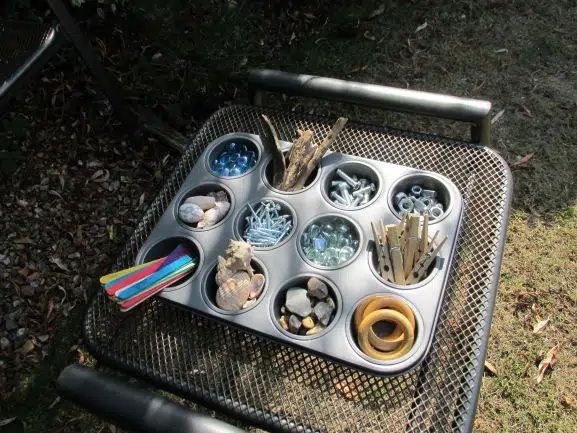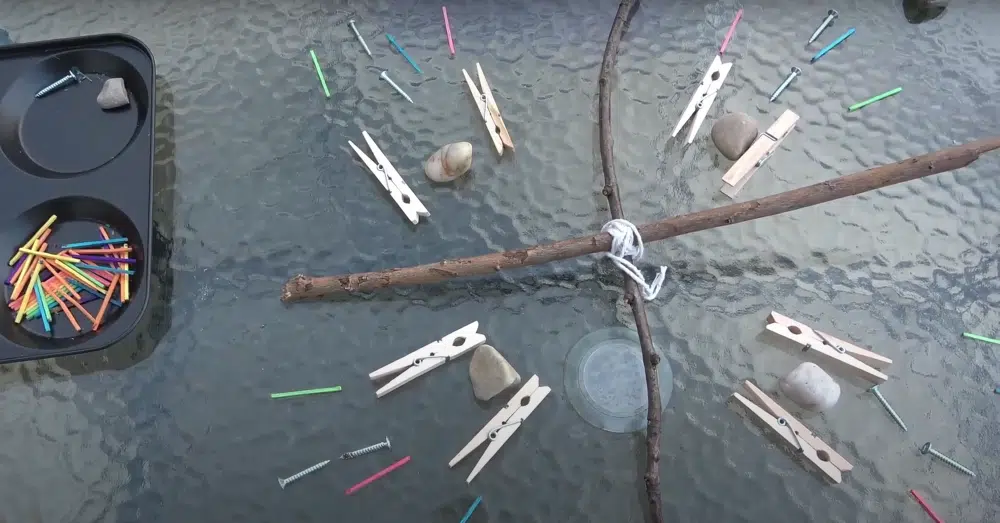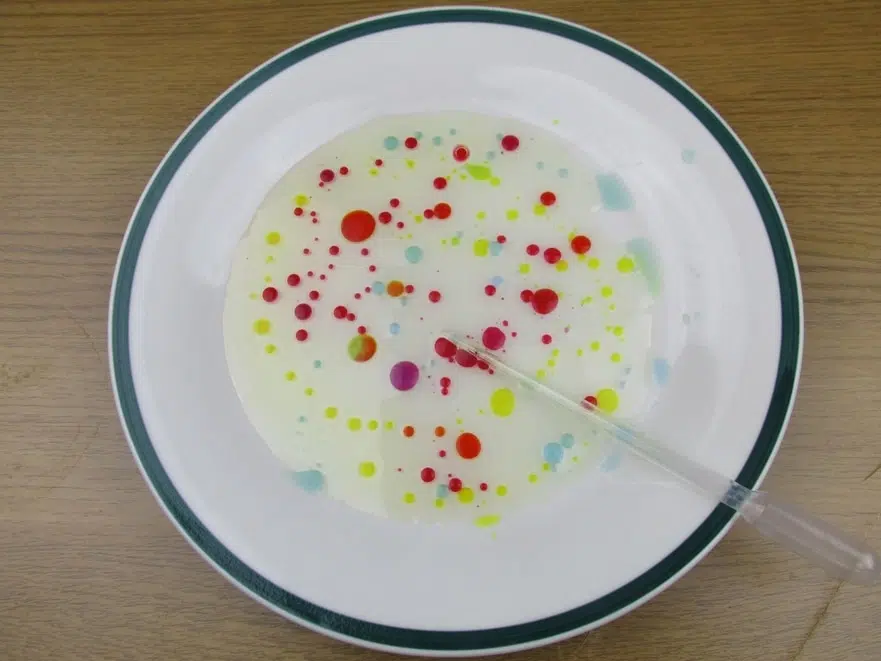Mandalas are beautiful geometric patterns. In my many years of teaching, I have found them to be a fantastic tool to inspire artistic exploration and children.
They are also a fantastic mindful tool, and many people use them as an aid to meditation.
For kids, they are a great way to experiment with form, color, and patterns, and a fantastic way to generate curiosity and talk.
In this post, I’ll look at my favorite 22 mandala activities.

1. Mirror Books
These are one of my all-time favorite loose parts activities, and they are brilliant for all kinds of open-ended mandala explorations.
To create a mirror book, simply tape two safety mirrors together to create a ‘book’.
I have created these mirror books out of both small and larger mirrors, and both work well.
The finished ‘mirror book’ will look like this:

You will also need a tray of some assorted loose parts (whatever you can find).
I used a tinker tray that looked like this:

Prop the mirror book open, and then place different loose parts inside the mirror book.
Explore what different patterns and imagery is created.
If you open the mirror book out wide, you only get a few reflections.
If you have the two mirrors quite close together, you create many multiple reflections.
These mirror books are fantastic for inspiring awe and wonder, and for generating curiosity, one of the main motivators of learning.
They also teach:
- An introduction to multiplication (and the many repeating images)
- An introduction to reflection
- About symmetry
- Simple counting opportunities
2. OHP Projector
An Overhead Projector is one of the ultimate mandala-creating resources.
You need something transparent to place on the OHP. There is a range of see-through colored plastic light toys that you can find cheaply for this purpose.
Aim the OHP at a nearby wall, and the children create mandala patterns on the lit-up surface. This activity is fantastic for generating a sense of awe and wonder.
3. Using Mirrors
This is probably the simplest activity on this whole list. It is a great way to introduce kids to mandalas for the first time.
You need some kind of large safety mirror for this. Place the mirror on a tabletop or on the floor.
Then you need a range of loose parts to create the mandalas with. It is good to use something with at least a bit of height, as this will produce longer reflections in the mirror.
Some good loose parts would include:
- Pebbles
- Clothespins (that could be balanced on their end)
- Large pom poms
- Launch shells
- Fruit such as lemons or limes
- Colored blocks
It is good for the children to have pictures of mandalas in close proximity to the mirrors (just for inspiration and so they can look at them).
Children place objects onto the mirror to create pictures and patterns.
The mirror really helps with generating curiosity and a sense of wonder.
In reality, the mandalas can look like pretty much anything. As with all mindful and art activities for this age, the process is much more important than the outcome.

4. Mirror On The Wall Or Box
Another way to use mirrors is to attach a safety mirror to the side of a cardboard box or attach one to the wall so that it rests with its bottom edge directly beside a tabletop.
Again this is an activity that works brilliantly with a range of loose parts in a tinker tray. That tinker tray would look something like this:

Children place a range of loose parts next to the mirror in any pattern they like. This array will be reflected in the mirror.
Once again a mirror is brilliant for inspiring curiosity and awe.
5. Drawing Giant Spirals
A nice way to get a structure into a mandala is for the adult to draw a giant spiral on a large surface, such as wallpaper on the floor.
With a range of loose parts, the kids can place objects in any pattern they choose on this spiral.
A more structured approach like this is great for children with the positioning schema.
Resources such as colored gems or differently colored pebbles work brilliantly for this.
6. Concentric Circles Scavenger Hunt
You can Take the idea of the last game and really expand it onto a larger scale by doing it outside.
Draw some giant concentric circles on the ground using chalk. You can do this over a 5 or 10-yard area.
Children then go on a scavenger hunt. They find natural objects such as stones, leaves, sticks, or plants. They bring them back and arrange them in a beautiful giant mandala on the concentric circles.
7. Snowflakes
I’m sure you’ve made these snowflakes before. Get circles or squares of paper, and fold them in half, then half again, and then half one final time.
Then cut along the folded edge.
It’s important not to cut all the way across, as that breaks the snowflake!
Just cut little snips and small shapes such as triangles and semi-circles into the snowflake. Then open them out, and wonder at the gorgeous snowflake mandala that you have created.
8. Sprinkling on Sugar
These snowflake mandalas can then be used for a range of different mandala art purposes.
For example, get some black card, place the snowflakes over it, and sprinkle over some kind of small granules such as sugar. Lift the snowflakes up to witness the beautiful mandala patterns below.

9. Coloring Mandalas
This is probably a really obvious one, but I thought I better include it.
You can print out all sorts of spectacular mandala patterns off the Internet for free, and many children will enjoy simply coloring these in.
There is a growing understanding in education of the therapeutic benefits of coloring for some people.
Although definitely not for everyone, some individuals find the following benefits in coloring:
- They become fully engaged in the present
- They experience a sense of calm while engaging with colour and form
- It is a mindful and therapeutic experience
10. Pre-Writing Pattern Mandalas
This is a great early writing activity.
Start with a giant spiral drawn on a large surface such as wallpaper on the floor.
Show the children how to draw a range of prewriting patterns around the mandala. For example, you can use:
- zigzags
- dots
- straight lines
- wiggly lines
- spirals
- waves
11. Stained Glass
This is a beautiful and simple art activity.
Cut out a shape of cling film. It could be a large circle or a large square.
Have a selection of pre-cut tissue paper and some PVA glue. The tissue paper will be cut into small squares (or other shapes).
The children stick The tissue paper pieces onto the cling film with the PVA glue. Hang up on a clothesline to dry.
12. Using Stickers
Many children are fascinated by using stickers, and they are great for fine motor because they are so fiddly to pick up and manipulate.
Have a range of colored or patterned stickers. And encourage the children to create mandalas using them.
You could use a structure, such as a large spiral, to give them a basis for creating a traditional-looking mandala.
Or you could just let them ‘freestyle’ and see what they come up with.
Either way, it’s good to have a selection of mandala pictures available for them to look at.
13. Stick Crosses
This is a great way to explore symmetry, and also mandalas using loose parts.
Have a tinker tray with a range of loose parts in.
Create a cross out of sticks. Quite simply, get two sticks of similar lengths, place one sideways over the top of the other, and attach with string so that they form a cross shape.
This is another activity that is brilliant for children with a positioning schema.
Children place loose parts in different sections of the cross. Many will place one object, for example, a shell, in one section, and then place another shell in each other section, before moving on to other objects.
The cross just provides a simple structure and framework to begin building a mandala.

14. Mandala Weaving
You can create beautiful mandalas by weaving around the stick crosses (see previous activity).
Select some lengths of colored wool or string.
The kids can wind these around the stick crosses, creating beautiful mandala-style patterns.
There are also weaving frames that you can buy that would create a similar effect.
15. Potato Printing
Remember this old classic from the archives!
A range of potatoes sliced in half and colored paint is a beautiful way to achieve some simple mandala-inspired art.
Once again it is the process that is all-important!
The adult can cut shapes into the potatoes, for a range of effects.
16. Mandalas In Puddles
if you live in a rainy environment, then it’s always good to have plenty of ideas available for what you can do with puddles!
Why not try puddle mandalas!
All you need, along with the puddle, are some pots of paint, and some paintbrushes.
Swirl paint through the puddles with the brushes. It will make all sorts of beautiful swirls and effects.
If you’re feeling really brave, you could get the children to squirt the paint straight into the puddles using squirty bottles! Not for the faint-hearted that one.
17. Pipette Mandalas
Simple pipettes are a fantastic tool to use for a range of artistic and fine motor ideas.
Cut out large circles of paper, and have some watered-down paint in pots.
Simply suck up some paint with the pipettes, and squirt it onto the circles of paper.
An adaptation of this is to first cover the paper in a mixture of icing sugar and water. This creates all sorts of beautiful blushings and star-like effects from the paint.

You can also make fantastic oil and water mandalas with pipettes.
Simply get a plate, and pour a thin layer of cooking oil over the surface. Then drop little droplets of colored paint onto the surface using the pipettes. The oil and paint create a beautiful effect that looks like this:

18. Sand And Mud Mandalas
Many children are obsessed with sand and mud, so why not take mandalas into those areas.
You can simply arrange loose parts, such as shells and pebbles, in the mud or sand.
Or you can stamp shapes into the mud using wellington boots.
19. Hole Punch Leaf Mandalas
You can these days get hole punches that create all sorts of different holes.
Some create circles, stars, hearts, squares – you name it!
Why not use these to create ‘mandalas’ on big leaves. Children simply punch a variety of holes onto the leaves and can see the light shining through the holes when they hold them up to the sky.
20. Sponge Painting On Circles
Here’s a nice simple one.
Cut out some large circles of paper, and then have a range of sponges.
The kids sponge differently colored paint over the large circle creating a fabulous mandala effect.
21. Mandala Mobiles
You can create mobiles quite simply using a range of materials.
For example, punch small holes into leaves, and suspend them from a coat-hanger using string.
You can also drill holes into log slices using small handheld drills, such as these:

You can thread string through the holes, and attach these log slices to a stick to create a beautiful mandala-inspired mobile.
22. Collage Of Colored Paper
Another nice simple one to finish.
Get a selection of different papers for the children to explore. These could include:
- Tissue paper
- Card
- Crepe paper
- Newspaper
The children cut and rip different sizes of paper, and stick them onto the circle, making a mandala effect.
The Benefits Of Mandalas
- They provide a sense of harmony and balance
- They are brilliant for children with a positional schema
- They are a mindful and therapeutic experience for many
- They provide a sense of awe and wonder and generate curiosity
- They are a stimulus for talk and speaking to others about thoughts and feelings
